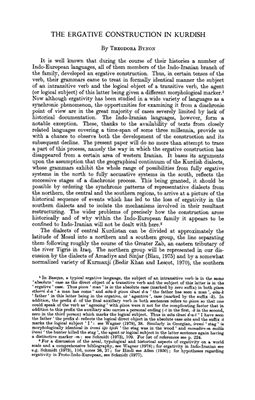This is well known that during the course of their histories a
number of.
Indo-European languages, all of them members of the Indo-Iranian branch of.
the family, developed an ergative construction. Thus, in certain tenses of the.
verb, their grammars came to treat in formally identical manner the subject.
of an intransitive verb and the logical object of a transitive verb, the agent.
(or logical subject) of this latter being given a different morphological marker.1.
Now although ergativity has been studied in a wide variety of languages as a.
synchronic phenomenon, the opportunities for examining it from a diachronic.
point of view are in the great majority of cases severely limited by lack of.
historical documentation. The Indo-Iranian languages, however, form a.
notable exception. These, thanks to the availability of texts from closely.
related languages covering a time-span of some three millennia, provide us.
with a chance to observe both the development of the construction and its.
subsequent decline. The present paper will do no more than attempt to trace.
a part of this process, namely the way in which the ergative construction has.
disappeared from a certain area of weste Iranian. It bases its arguments.
upon the assumption that the geographical continuum of the Kurdish dialects,
whose grammars exhibit the whole range of possibilities from fully ergative.
systems in the north to fully accusative systems in the south, reflects the.
successive stages of a diachronic process. This being granted, it should be.
possible by ordering the synchronic pattes of representative dialects from.
the northe, the central and the southe regions, to arrive at a picture of the.
historical sequence of events which has led to the loss of ergativity in the.
southe dialects and to isolate the mechanisms involved in their resultant.
restructuring. The wider problems of precisely how the construction arose.
historically and of why within the Indo-European family it appears to be.
confined to Indo-Iranian will not be dealt with here/.
Indo-European languages, all of them members of the Indo-Iranian branch of.
the family, developed an ergative construction. Thus, in certain tenses of the.
verb, their grammars came to treat in formally identical manner the subject.
of an intransitive verb and the logical object of a transitive verb, the agent.
(or logical subject) of this latter being given a different morphological marker.1.
Now although ergativity has been studied in a wide variety of languages as a.
synchronic phenomenon, the opportunities for examining it from a diachronic.
point of view are in the great majority of cases severely limited by lack of.
historical documentation. The Indo-Iranian languages, however, form a.
notable exception. These, thanks to the availability of texts from closely.
related languages covering a time-span of some three millennia, provide us.
with a chance to observe both the development of the construction and its.
subsequent decline. The present paper will do no more than attempt to trace.
a part of this process, namely the way in which the ergative construction has.
disappeared from a certain area of weste Iranian. It bases its arguments.
upon the assumption that the geographical continuum of the Kurdish dialects,
whose grammars exhibit the whole range of possibilities from fully ergative.
systems in the north to fully accusative systems in the south, reflects the.
successive stages of a diachronic process. This being granted, it should be.
possible by ordering the synchronic pattes of representative dialects from.
the northe, the central and the southe regions, to arrive at a picture of the.
historical sequence of events which has led to the loss of ergativity in the.
southe dialects and to isolate the mechanisms involved in their resultant.
restructuring. The wider problems of precisely how the construction arose.
historically and of why within the Indo-European family it appears to be.
confined to Indo-Iranian will not be dealt with here/.

